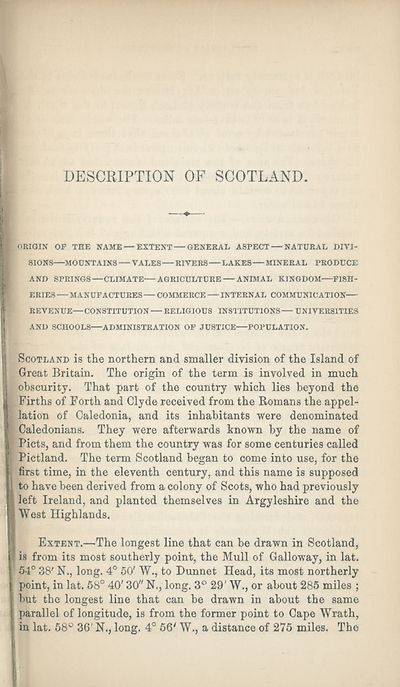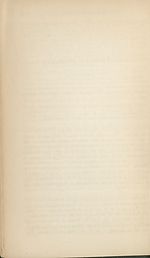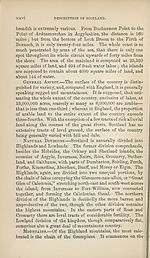Download files
Complete book:
Individual page:
Thumbnail gallery: Grid view | List view

DESCRIPTION OF SCOTLAND.
.ORIGIN OP THE NAME—EXTENT GENERAL ASPECT NATURAL DIVI¬
SIONS MOUNTAINS VALES RIVERS LAKES MINERAL PRODUCE
AND SPRINGS—CLIMATE AGRICULTURE ANIMAL KINGDOM FISH¬
ERIES MANUFACTURES COMMERCE INTERNAL COMMUNICATION
REVENUE—CONSTITUTION RELIGIOUS INSTITUTIONS UNIVERSITIES
AND SCHOOLS ADMINISTRATION OF JUSTICE POPULATION.
Scotland is the northern and smaller division of the Island of
Great Britain. The origin of the term is involved in much
obscurity. That part of the country which lies beyond the
.Firths of Forth and Clyde received from the Romans the appel¬
lation of Caledonia, and its inhabitants were denominated
[Caledonians. They were afterwards known by the name of
Piets, and from them the country was for some centuries called
Pictland. The term Scotland began to come into use, for the
first time, in the eleventh century, and this name is supposed
to have been derived from a colony of Scots, who had previously
left Ireland, and planted themselves in Argyleshire and the
West Highlands.
Extent.—The longest line that can be drawn in Scotland,
is from its most southerly point, the Mull of Galloway, in lat.
64° 38' N., long. 4° 50' W., to Dunnet Head, its most northerly
point, in lat. 58° 40' 30" N., long. 3° 29' W., or about 285 miles ;
but the longest line that can be drawn in about the same
parallel of longitude, is from the former point to Cape Wrath,
in lat. 58° 36' N., long. 4° 56' W., a distance of 275 miles. The
.ORIGIN OP THE NAME—EXTENT GENERAL ASPECT NATURAL DIVI¬
SIONS MOUNTAINS VALES RIVERS LAKES MINERAL PRODUCE
AND SPRINGS—CLIMATE AGRICULTURE ANIMAL KINGDOM FISH¬
ERIES MANUFACTURES COMMERCE INTERNAL COMMUNICATION
REVENUE—CONSTITUTION RELIGIOUS INSTITUTIONS UNIVERSITIES
AND SCHOOLS ADMINISTRATION OF JUSTICE POPULATION.
Scotland is the northern and smaller division of the Island of
Great Britain. The origin of the term is involved in much
obscurity. That part of the country which lies beyond the
.Firths of Forth and Clyde received from the Romans the appel¬
lation of Caledonia, and its inhabitants were denominated
[Caledonians. They were afterwards known by the name of
Piets, and from them the country was for some centuries called
Pictland. The term Scotland began to come into use, for the
first time, in the eleventh century, and this name is supposed
to have been derived from a colony of Scots, who had previously
left Ireland, and planted themselves in Argyleshire and the
West Highlands.
Extent.—The longest line that can be drawn in Scotland,
is from its most southerly point, the Mull of Galloway, in lat.
64° 38' N., long. 4° 50' W., to Dunnet Head, its most northerly
point, in lat. 58° 40' 30" N., long. 3° 29' W., or about 285 miles ;
but the longest line that can be drawn in about the same
parallel of longitude, is from the former point to Cape Wrath,
in lat. 58° 36' N., long. 4° 56' W., a distance of 275 miles. The
Set display mode to:
![]() Universal Viewer |
Universal Viewer | ![]() Mirador |
Large image | Transcription
Mirador |
Large image | Transcription
| Antiquarian books of Scotland > Scotland/Scots > Black's picturesque tourist of Scotland > (31) |
|---|
| Permanent URL | https://digital.nls.uk/130028562 |
|---|
| Description | Thousands of printed books from the Antiquarian Books of Scotland collection which dates from 1641 to the 1980s. The collection consists of 14,800 books which were published in Scotland or have a Scottish connection, e.g. through the author, printer or owner. Subjects covered include sport, education, diseases, adventure, occupations, Jacobites, politics and religion. Among the 29 languages represented are English, Gaelic, Italian, French, Russian and Swedish. |
|---|

